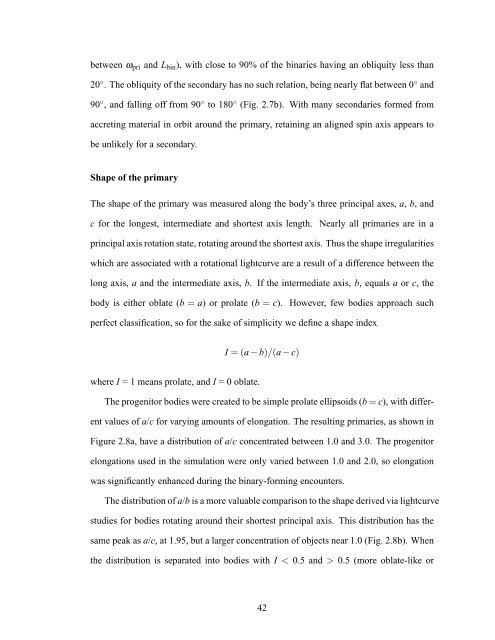Forming Binary Near-Earth Asteroids From Tidal Disruptions
Forming Binary Near-Earth Asteroids From Tidal Disruptions
Forming Binary Near-Earth Asteroids From Tidal Disruptions
Create successful ePaper yourself
Turn your PDF publications into a flip-book with our unique Google optimized e-Paper software.
etween ω pri and L bin ), with close to 90% of the binaries having an obliquity less than20 ◦ . The obliquity of the secondary has no such relation, being nearly flat between 0 ◦ and90 ◦ , and falling off from 90 ◦ to 180 ◦ (Fig. 2.7b). With many secondaries formed fromaccreting material in orbit around the primary, retaining an aligned spin axis appears tobe unlikely for a secondary.Shape of the primaryThe shape of the primary was measured along the body’s three principal axes, a, b, andc for the longest, intermediate and shortest axis length. <strong>Near</strong>ly all primaries are in aprincipal axis rotation state, rotating around the shortest axis. Thus the shape irregularitieswhich are associated with a rotational lightcurve are a result of a difference between thelong axis, a and the intermediate axis, b. If the intermediate axis, b, equals a or c, thebody is either oblate (b = a) or prolate (b = c). However, few bodies approach suchperfect classification, so for the sake of simplicity we define a shape indexI = (a − b)/(a − c)where I = 1 means prolate, and I = 0 oblate.The progenitor bodies were created to be simple prolate ellipsoids (b = c), with differentvalues of a/c for varying amounts of elongation. The resulting primaries, as shown inFigure 2.8a, have a distribution of a/c concentrated between 1.0 and 3.0. The progenitorelongations used in the simulation were only varied between 1.0 and 2.0, so elongationwas significantly enhanced during the binary-forming encounters.The distribution of a/b is a more valuable comparison to the shape derived via lightcurvestudies for bodies rotating around their shortest principal axis. This distribution has thesame peak as a/c, at 1.95, but a larger concentration of objects near 1.0 (Fig. 2.8b). Whenthe distribution is separated into bodies with I < 0.5 and > 0.5 (more oblate-like or42












